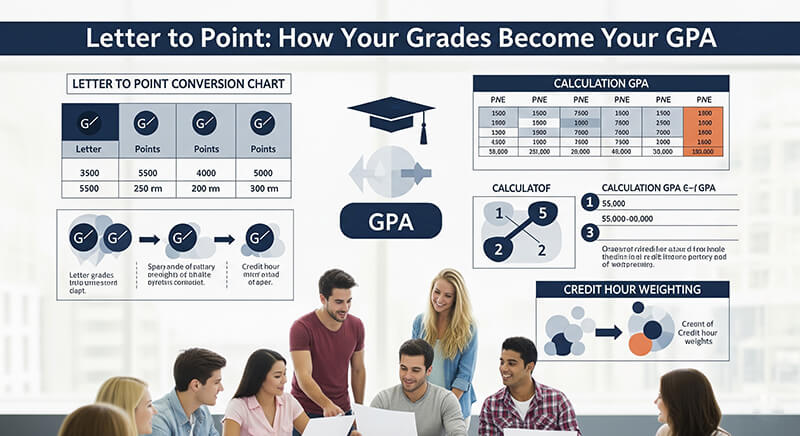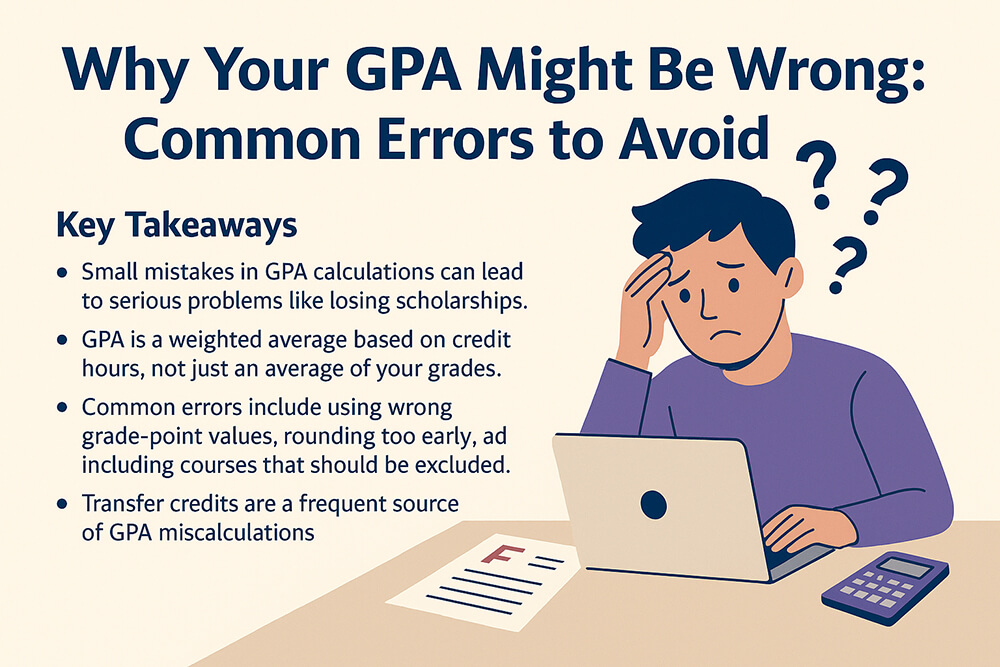A Semester/Term GPA Tool helps you plan your academic success. It is more than a simple calculator. It is a way to set goals, track your progress, and make smart choices about your classes. By using this tool, you can see how your grades in one term affect your long-term goals.
Key Takeaways
| Feature | Benefit |
|---|---|
| GPA Calculation | Instantly see your GPA for the current semester based on expected grades. |
| Goal Setting | Plan the grades you need to achieve a target GPA for the Dean's list or other honors. |
| Scenario Planning | See how a lower grade in one class might impact your overall semester GPA. |
| Mid-Term Check | Use your mid-term grades to project your final course grades and adjust your study plan. |
| Special Cases | Understand how pass/fail classes or incomplete grades can change your academic standing. |
Understanding the Semester/Term GPA Tool
A college GPA calculator is a simple tool for students. You enter your courses, credit hours, and expected grades. The tool then shows you your GPA for that term. This helps you see your academic standing at any time. You do not have to wait for the end of the semester. This gives you control over your academic future.
You can use the tool to set goals. For example, if you want a 3.5 GPA, you can see what grades you need to get it. This turns a big goal into smaller, clear steps. It helps you plan which classes need more of your attention.
The Basics of GPA Calculation
Your GPA is an average of your grades. Some classes have a bigger impact on your GPA than others. This is because of credit hours. To understand your GPA, you need to know about three main parts.
- Credit Hours: This number shows how much a class is worth. A 4-credit class will change your GPA more than a 1-credit class. A guide to credit hour weighting can explain this more.
- Letter Grades: These are the A, B, and C grades you get. Each letter has a number value. You can find these values in a letter to point GPA conversion guide.
- Quality Points: You get quality points for each class. To find them, you multiply the grade's number value by the credit hours. Learning about quality points vs. GPA is key to understanding your transcript.
The basic GPA formula guide is simple. You add up all your quality points. Then you divide that number by the total credit hours.
Weighted vs. Unweighted GPA
Schools sometimes use a weighted GPA. This gives more value to harder classes, like Honors or AP courses. A guide on GPA weighting for Honors and AP can show how an A in an AP class might be worth 5.0 points instead of the usual 4.0.
Understanding weighted vs. unweighted GPA is important. It helps you see the true value of your hard work in difficult classes. There are many weighted GPA myths that have been debunked, so it is good to learn the facts. A weighted vs. unweighted GPA calculator can show you both numbers.
Using Special GPA Calculators
Different schools and programs have unique needs. For example, some high schools use different scales, which a 5.0 GPA scale guide can explain. Students with international credits might need an IB to GPA conversion guide to see how their grades translate.
Even school districts can have different rules. Learning how school districts calculate GPA can clear up confusion. For students on a different academic calendar, a trimester GPA calculator is a useful tool.
Strategic Planning with Your GPA Tool
Your GPA tool is perfect for planning. The Mid-Term Grade Projection Slider lets you use your current grades to predict your final grades. This can be a wake-up call to study harder.
You can also plan for specific goals. A Dean's List eligibility checker helps you figure out the grades you need for special honors. For upperclassmen, a last 60 credits GPA calculator can be useful for graduate school applications. Even new students can plan ahead with a freshman year GPA predictor.
Handling Special Academic Situations
College life can be unpredictable. Sometimes you may need to take an incomplete grade. A planner for GPA planning for incomplete grades can show you how this might affect your future GPA. You can model different outcomes with an incomplete grades scenario planner.
Other situations also need special tools.
- A repeat course GPA recalculator shows how retaking a class can boost your GPA.
- A transfer credits GPA integrator helps you see how classes from another school will count.
- A dual degree GPA splitter is essential for students in multiple programs.
- Learning how pass/fail grades impact your GPA is important before choosing that option.
Avoiding Common Mistakes
It is easy to make mistakes when calculating your GPA. Knowing the common GPA calculation errors to avoid can save you from stress. It is always a good idea to double-check your numbers.
To be sure your GPA is correct, you can perform a self-check. A transcript GPA audit guide can walk you through the steps. This helps you catch any errors and understand your transcript better.
GPA Tools for All Students
GPA calculators are not just for college students. A high school GPA calculator can help younger students prepare for college applications. These tools are designed to work for anyone who needs to track their grades.
The main website, www.thegpacalculator.com, offers a variety of tools for different needs. Whether you are in high school or college, you can find a calculator to help you succeed. Learning how to calculate GPA is the first step toward taking control of your academic journey.
It is also interesting to understand the bigger picture. Topics like GPA inflation vs. deflation can help you understand how your GPA is viewed by others. This knowledge helps you set realistic and competitive goals for your future.
Frequently Asked Questions (FAQ)
What is a Semester/Term GPA Tool? A Semester/Term GPA Tool is an online calculator that helps students determine their Grade Point Average for a specific academic term. You input your courses, credit hours, and grades to see your GPA.
How do I calculate my semester GPA? To calculate your semester GPA, you multiply the grade point value for each course by its number of credit hours to get the quality points. Then, you add up all the quality points and divide by the total number of credit hours.
What is the difference between quality points and GPA? Quality points are calculated for each course by multiplying the grade's value by the credit hours. Your GPA is the average of these points, found by dividing the total quality points by the total credit hours.
Can I use a GPA tool to predict my final grades? Yes, many GPA tools have features that allow you to project your final grades based on your mid-term performance. This helps you see what scores you need on final exams to reach your goal grade.
How do incomplete grades affect my GPA? An initial "I" grade does not affect your GPA. However, once you complete the coursework and receive a final grade, that grade is factored into your cumulative GPA. If you miss the deadline, it often turns into an 'F', which will lower your GPA.










